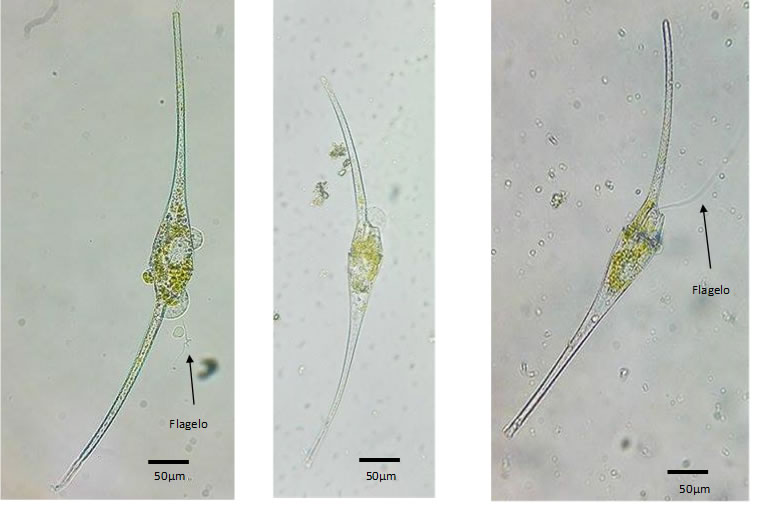Colombia has a bioluminescent beach: What's lighting up the water?
It is well known that many scientific discoveries happen by accident. The beaches of the Gulf of Urabá in northwestern Colombia, have become a natural laboratory for the study of one of the most spectacular phenomena exhibited by nature: a bioluminescent sea.
As night falls on the beaches of the town of Turbo, a municipality located in the Gulf of Urabá, northwestern Colombia, a little-documented phenomenon occurs. Apparently, a massive proliferation of algae in Colombian coasts are causing what is known as bioluminescence, a bizarre phenomenon that makes the sea shine.
Scientifically, bioluminescence is a phenomenon caused by algal blooms during which algae become so numerous that they discolor coastal waters. Certain marine organisms such as dinoflagellates, a type of algae that have the ability to produce light through a chemical process involving substances such as luciferin (a protein) and luciferase (an enzyme) are responsible for creating this phenomenon in the waters of the Colombian Caribbean.
The interaction of these substances with oxygen (O2) and calcium ions (Ca2+) creates a reaction that releases excess energy as light within a few milliseconds. Then luciferase, which is the end-product, is oxidized.
Recent studies show that physics also plays a major role in promoting the production of bioluminescence (Latz et al, 2008). Apparently, mechanical stress generated by the movement of the waves promotes light emission. The blue light occurs because blue is the prevalent color in deep sea waters, while other colors such as red are quickly absorbed by water molecules in the ocean.
There are many reasons why bioluminescence occurs and it will depend on the type of organism involved in this process. For example, some marine organisms use bioluminescence as a mechanism to find mates, while others use it to hunt prey, defend against predators or when disturbed.
Apparently, populations of Ceratium fusus in the waters of the Gulf of Urabá generate bioluminescence as a defense mechanism. When a predator tries to catch dinoflagellates, these produce a flash of light that startles the predator thus leading to reduced grazing. The flash of light can also attract predators resulting in what scientists call the “burglar alarm effect”.
Why is this discovery important?
The Gulf of Urabá is part of the wider Caribbean Bassin, an area where the freshwater from the Atrato river (one of Colombia’s largest rivers) mixes with salt water from the Caribbean Sea giving rise to an estuarine system.
Considered Colombia's third richest region and one of the world's largest exporters of bananas, the region of Urabá remains surprisingly unexplored.
As for biodiversity, this area is one of the few places in the world where populations of marine phytoplankton, especially estuarine species, are yet unknown.
Studies conducted in the continental margin of the Colombian Caribbean Sea revealed that marine phytoplankton populations consist mainly of two major groups: diatoms and dinoflagellates (Lozano-Duque et al., 2010). 35 species of the genus Ceratum have been reported from habitats ranging from La Guajira Peninsula in the northern tip of Colombia, to the Gulf of Urabá.
Sea-water samples collected at Barajas, a local beach located a few minutes from the town of Turbo, revealed high concentrations of nutrients due to the presence of fertilizers in tributaries that run along nearby banana plantations, and poor wastewater treatment. This creates a "soup of algae", which along with a wide variety of factors including currents, winds, river flows, topography, and even lunar phases, make the beaches of Turbo an unparalleled site to see bioluminescence.

Ceratium fusus, a species of bioluminescent dinoflagellates, appears to be the cause off bioluminescence in the Bay of Barajas, Colombia
This interaction creates an environment conducive to growth of Ceratium fusus, a species of bioluminescent dinoflagellates never before reported in these area of Colombia. C. fusus is generally considered to be a cosmopolitan species (which occurs in tropical, subtropical and temperate sea waters). Although not considered toxic, excessive growth of these organisms can lead to low levels of oxygen in the surface layers of the ocean.
Bioluminescence in other areas of the world
In October 2011, a similar phenomenon occurred in San Diego, California. The cause of bioluminescence off San Diego coast was a species of dinoflagellates called Lingulodinium polyedrum. While Ceratium fusus seems to be the dominant species of dinoflagellates found in the samples collected at Turbo by a team of students of the UdeA Marine Science facilities.
Although this phenomenon may disappear within days, it occurs seasonally in other areas of the world. In Vieques, Puerto Rico, this phenomenon attracts thousands of tourists from around the world, which generates significant revenues to this island.
Thus, Barajas, Colombia, can be included in the list of the brightest bioluminescent bays in the world, which includes Cairns and Gippsland Lakes (Australia), Manasquan Beach, NJ (USA), Mission Bay and Torrey Pines State Beach, San Diego, CA (USA), Luminous Lagoon, Trelawny (Jamaica), Mosquito Bay, Vieques (Puerto Rico), Halong Bay (Vietnam), Bali (Indonesia), Tonsai Bay, Krabi (Thailand), Toyama Bay (Japan), Zeebrugge (Belgium), Norfolk (UK), and Reethi Beach (Maldives).

No comments:
Post a Comment